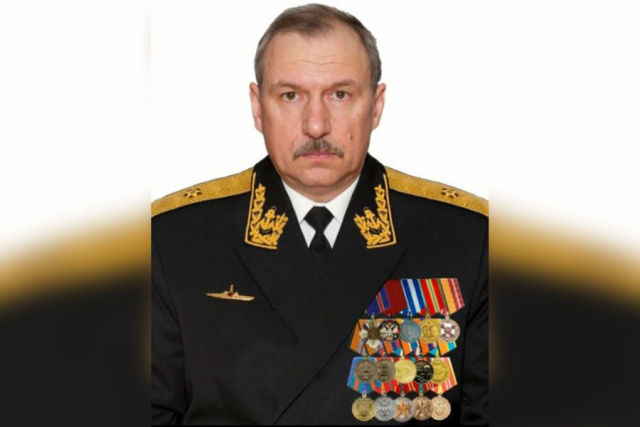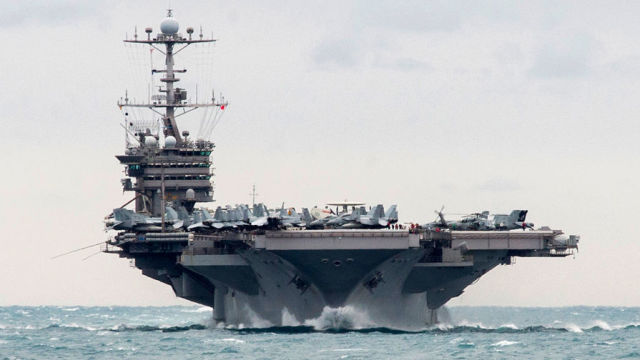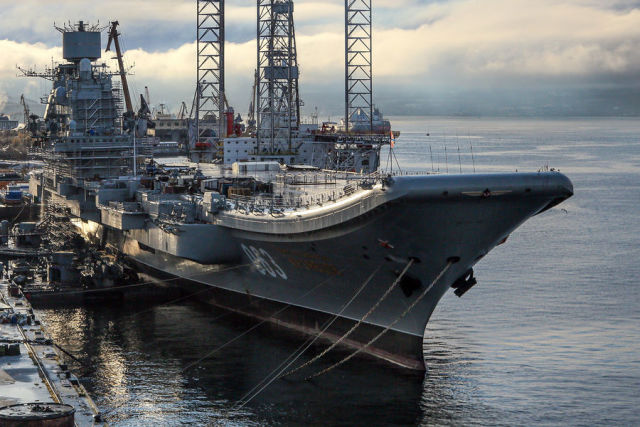Rear Admiral Mikhail Chekmasov spoke about the prospects of Russian aircraft carriers
The Admiral Kuznetsov, the only heavy aircraft carrier in the Russian Navy, will return to the fleet after repairs in the first quarter of 2024. About why new aircraft carriers have not appeared in Russia for 30 years and how the domestic military fleet can resist NATO carrier strike groups (AUG) - in an interview with Gazeta.Ru" said Rear Admiral of the reserve, military expert Mikhail Chekmasov.
- NATO countries conducted the Baltops-2022 exercises in the Baltic. Even earlier, the US Navy completed exercises with the South Korean Navy. To what extent are aircraft carriers frequent participants in such exercises and what does their involvement mean?
- One aircraft carrier from the British Navy Queen Elizabeth participated in the Baltops-2022 exercises. The US Navy's Kearsarge is a versatile amphibious assault ship. It would not be superfluous to note the participation of another large landing ship dock from the US Navy - Gunston Hall.
The composition of the forces involved depends on the tasks being worked out during the exercises and aircraft carriers are not always involved. For example, the US aircraft carrier was involved in the NATO Trident Juncture-2018 exercise, which was held in the Norwegian Sea for the first time in the last 30 years.
Judging by the composition of the participants of Baltops-2022 - in addition to the already mentioned forces, two guided missile destroyers (URO), three URO frigates, five corvettes and patrol ships, another landing ship from Poland participated in them - it is not difficult to assume that mine action and amphibious landing were practiced.

Rear Admiral Mikhail Chekmasov
Image source: Photo from personal archive
- Last December, an American carrier strike group led by the aircraft carrier USS Harry Truman entered the Mediterranean Sea. According to the Pentagon, this group will remain there until August, then it will be replaced by another. Does the presence of an aircraft carrier group in the Mediterranean complicate the situation on the Black Sea, especially against the background of statements in a number of Western media that the United States is ready to strike at the Russian Black Sea Fleet if its ships continue to block the ports of Ukraine and do not ensure the safe export of grain?
- The deployment of US aircraft carriers with escort ships to the Mediterranean has been commonplace since the Cold War as part of the forward presence and implementation of their "Sea Power XXI" strategy.
The export of Ukrainian grain is not a problem for Russia, but it gives the West a reason to "hang" responsibility for it on it. The reason is very flimsy and they will not be able to "appoint a switchman". This was stated by Russian President Vladimir Vladimirovich Putin, and relevant statements were made by the Ministry of Defense and other departments.
It is enough to look at the "Notices to Seafarers" (an international collection notifying about all changes and innovations in the navigational situation of the seas of the whole world, as well as about newly discovered maritime dangers - ed.) to make sure that civil navigation in the Black Sea is not blocked by anyone except Ukraine itself. In addition, the infrastructure of the Ukrainian port of Izmail on the Danube is quite suitable for grain export in any direction. On the Danube itself, including this port, and on the approaches to it from the Black Sea, in addition to ships of other states, ships under the flag of Ukraine are also stationed.
Therefore, statements in the media, whoever they may be, about the readiness to strike the Black Sea Fleet from the Mediterranean Sea through the air spaces of other states, even if they are NATO members, are so far nothing more than a "blank shot" shaking the air. However, I will not deny its possibility in principle, because there may be a "hothead"...

Aircraft carrier USS Harry S. Truman, 2015
Image source: M. J. Lieberknecht/U.S. Navy via AP
- How do US aircraft carrier groups operate and how can the Russian fleet resist them?
- It's no secret that the United States has the most extensive experience in the use of AUGS, which are the central link of all their maritime concepts since the Second World War. But if in World War II they were used in naval battles in the Pacific Ocean against the Japanese fleet on the principle of "fleet against fleet", then in post-war armed conflicts the main principle of application was "fleet against the coast".
At the same time, in both cases, the main striking force was carrier-based aircraft. With the development of technologies, and after them the means of destruction, the share of aviation in strikes against objects on the territories of the attacked states began to shift in favor of sea-based cruise missiles, but did not replace it.
In military educational institutions, separate lectures are devoted to how AUG works and how it can be resisted. The task of defeating the enemy's AUG is quite solvable for the Russian Navy together with the Aerospace Forces. For this purpose, new missiles have already been created, including hypersonic "Zircon" and "Dagger".
Regarding the advantages of a fleet that has an aircraft carrier, it should be noted that in the post-war period, US AUGS were used practically in landfill conditions, without real opposition from opponents. In relation to Russia and China, this option will not work - a rebuff will be inevitable.
- In the USA, stealth aircraft carriers of the Gerald R. Ford type are being created, which differ from the previous Nimitz type by the introduction of a number of new technologies. They have an electromagnetic catapult, a new design of an aerial finisher, and a new design of lifts - the share of novelty is off the scale for 50%. Won't such an excess of innovations play a cruel joke with stealth aircraft carriers?
- The Americans have not only a unique experience in the use of aircraft carriers, but also a huge experience in their design and construction - this is objective. An aircraft carrier in the US Navy, or rather AUG, is a sacred cow, a tool for projecting power in any crisis area of the World Ocean.
I think they will find the necessary solutions, but at the cost of abandoning some unfinished systems in favor of used serial ones during the construction of subsequent ships of this type.
- There are 11 aircraft carriers in the US Navy. In fact, Russia does not have a single such ship. The only heavy aircraft carrier "Admiral Kuznetsov" is under repair and will return to service, according to the latest data, in 2024. Does the Russian Navy need another aircraft carrier or several aircraft carriers?
- The need for aircraft carriers in the USSR and Russia has been discussed since the end of the Great Patriotic War. Their construction was envisaged in two ten-year programs from 1946 to 1955 and from 1956 to 1965. These programs were proposed by Admiral of the Fleet of the Soviet Union Nikolai Gerasimovich Kuznetsov, but they were rejected by the leadership of the state.
Only thanks to the efforts of the Admiral of the Fleet of the Soviet Union, the organizer of the domestic nuclear missile fleet Sergei Georgievich Gorshkov, whose years of management of the USSR Navy are considered the golden age of military shipbuilding, from 1971 to 1990 it was possible to build five aircraft carriers and two more were at the plant in Nikolaev in varying degrees of readiness.
It is difficult to imagine with what feelings naval officers in the perestroika-post-Soviet period were forced to silently watch how the fleet was being cut "to needles" and sold "Novorossiysk" to South Korea, "Kiev", "Minsk" and "Varyag" to China, and "Gorshkov" to India. The last two at least continue to serve in friendly states under other names, but they could have been with us.
According to the Fundamentals of Russia's State Policy in the field of Naval Activities for the period up to 2030, which were approved by the decree of the President of Russia in 2017, the creation of a marine aircraft carrier complex is planned as one of the priorities in the field of construction and development of the Navy.
That is, positive decisions have been made on this issue.
- "Admiral Kuznetsov" was baptized in Syria. Of course, he will return to the fleet after repairs, but in a strategic sense, how self-sufficient is he?
- No aircraft carrier, no matter whose it is, is self-sufficient. Therefore, the task is to create a marine aircraft carrier complex. Simply put, we are not talking about the construction of a single aircraft carrier, but about an integrated approach to solving this problem.
I think it is advisable to consider it as part of the creation of aircraft carrier formations, which we had as part of the Northern and Pacific Fleets. Of course, these are not only aircraft carriers. They should include multipurpose ships of the ocean and far-sea zones that meet modern and even promising requirements for weapons and control systems.
A Su-33 fighter jet before taking off from the deck of the Admiral Kuznetsov cruiser off the coast of Syria in the Mediterranean Sea. The Admiral Kuznetsov cruiser and the Admiral Grigorovich TFR are involved in the operation in Syria for the first time
Image source: RIA Novosti
- Why has the Russian Navy not had new aircraft carriers in 30 years? What are the reasons: production capabilities, home docks? And does Russia have the ability to build an aircraft carrier today in principle?
- This is a sad story in the construction and development of the Russian fleet. The leading and guiding role of the CPSU led to the collapse of the country - the actors are known and there is nothing to add here...
All our aircraft-carrying cruisers were built in Nikolaev, that is, on the territory of the Ukrainian SSR. There were no other production facilities for such large ships. After the collapse of the USSR, there was no money even for salaries. For maintenance, fuel, repairs, bringing to mind the basing system, docking and other shipboard joys, funding was very limited.
Currently, the construction of large ships and vessels in Russia is gradually being restored, new technologies are being mastered, new experience is being acquired.
So Russia will find where to build its new aircraft carrier fleet.
- Do the tasks of the Russian Navy change against the background of the special operation in Ukraine and the related activities of NATO forces? The United States has created dozens of ships to be present in the far sea zone, while Russia operated mainly in the near. Do we need to move away from our shores?
- Based on the experience of my service, I think that the tasks do not change. The Black Sea Fleet takes direct part in the special military operation, the rest of the fleets and the Caspian Flotilla are engaged in planned preparation and performance of their tasks in the near and far sea zones. Since 2013, an operational unit of the Russian Navy has been created in the Mediterranean Sea and performs tasks on a permanent basis, so that the US aircraft carrier Harry Truman, which is present there, will not remain without due attention.
Then there was a time when we stood at the berths and went out to sea only to maintain the minimum permissible level of training. Changes for the better came in the early 2000s. The fleet began to gradually return to the World Ocean and cause trouble to "Western partners".
I can give some examples, since I was directly involved in many of them: the deployment of detachments of warships led by the cruiser Admiral of the Fleet of the Soviet Union N.G. Kuznetsov to the Atlantic and the Mediterranean in 2004, 2007, 2011 and 2016, the campaign to the North Pole of the K-84 missile submarine in 2006, the cruiser "Peter the Great" and the large anti-submarine ship "Admiral Chabanenko" to Venezuela in 2008-2009 with access to the Pacific Ocean by the Panama Canal ("Chabanenko") and around Africa to the Gulf of Aden ("Peter the Great"), the transition of the cruiser "Peter the Great" from the Northern to the Pacific Fleet by the southern route to 2010 and deployment to the Arctic in 2012, the campaign of detachments of warships of the Pacific, Black Sea and Baltic fleets to the shores of Australia in 2014, and many others.
Therefore, to say that "Russia acted mainly in the near zone" is not entirely true.
Irina Alshayeva

